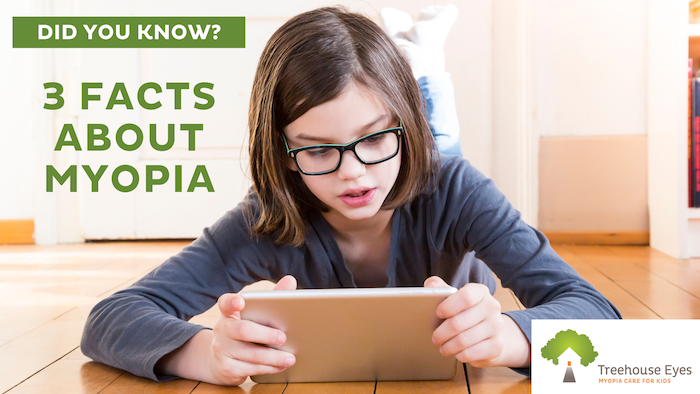3 Facts about Myopia and What You Can Do For Your Child

Myopia, often referred to as nearsightedness, is an eye disease in which the eye elongates more than it should, causing light to be focused in front of the retina instead of on the retina’s surface. Essentially, your child’s eye is growing too long.
Because the eye elongates and grows with the rest of the body, naturally, it stops elongating once the rest of the body stops growing in early adulthood. This also means there may be times in a child’s development where they experience growth spurts—suddenly requiring a higher prescription due to an increase in their myopia.
The hallmark symptom of myopia is blurred distance vision, but it can also cause headaches, eyestrain, and difficulty seeing at night.
What Causes Myopia?
Several factors lead a child to develop myopia, including genetic, environmental, and even socioeconomic status.
Excessive ‘Near Work’
More than ever before, kids all over the world are focusing their eyes on near objects for the majority of their day, whether reading a book, or using a smartphone, computer, tablet, or another device.
Numerous studies have shown that doing near work, especially in excess (more than 3 hours per day), contributes to the onset and progression of myopia.
Some findings suggest that the intensity and duration of near work are also important factors. For example, reading a captivating novel for 45 minutes straight will impact a child’s eyes more than skimming a magazine a few minutes at a time.
Genetics
A child is more likely to be myopic if one of their parents is nearsighted or myopic as well. If both parents are myopic, those chances increase even greater. Be sure to get your child’s vision checked if you or your spouse are myopic.
Not Enough Outdoor Time
Spending at least 2-3 hours outdoors has been shown to delay or prevent the onset of myopia in children. Make sure to send your children outside to play every day, especially if they’re at risk of developing myopia!
What Can You Do?
The good news is there are many things you can do you help slow or stop the progression of myopia.
Get Regular (annual or semi-annual) Eye Exams
Even if both parents aren’t myopic, it’s still recommended to get an annual eye exam for your child. You can schedule a myopia consultation with a Treehouse Eyes provider near you. Many pediatricians are able to complete basic eye exams – be sure to ask them to check for myopia!
Encourage Breaks from Excessive ‘Near Work’
More than ever before, kids are focusing their eyes on near objects for the majority of their day. Encouraging breaks from near work such as reading and electronic devices will help your child’s eyes and give them a chance to get back outside as it warms up.
Spend More Time in Natural Sunlight
As you encourage your child to take a break from near work, one of the best ways to enjoy that newfound time is to get outside! Natural sunlight, even in the classroom, can be protective of myopia. Be sure to wear some sunblock as well!
If Your Child Has Myopia, We Can Help!
What many don’t realize is that myopia can seriously affect a child’s future eye health and vision. Having myopia in childhood significantly increases the risk of developing serious eye diseases and conditions like glaucoma, retinal detachment, cataracts, and macular degeneration in adulthood.
The good news is that myopia can be effectively managed to reduce the risk of future eye disease. You can prevent serious, sight-robbing eye diseases by scheduling your child’s myopia consultation with us today. Visit Tomasino Goerss Vision Source, by making an appointment online, or calling our office today at (636) 272-1444. Help your child’s quality of life improve before your eyes!